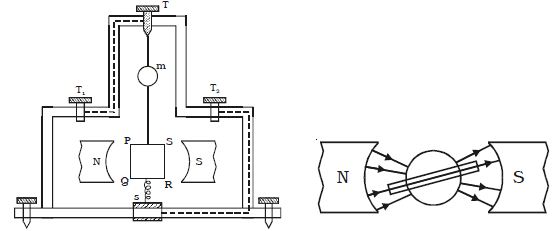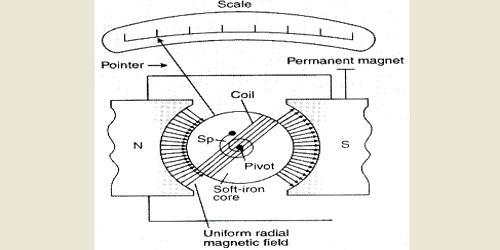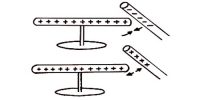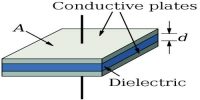Moving coil galvanometer works on the principle that a current-carrying coil placed in a magnetic field experiences a torque. It is an instrument which is used to measure electric currents. It is a sensitive electromagnetic device that can measure low currents even of the order of a few microamperes.
Principle – A current-carrying coil when placed in an external magnetic field experiences magnetic torque. The angle through which the coil is deflected due to the effect of the magnetic torque is proportional to the magnitude of current in the coil.
Moving Coil Galvanometer Construction
It consists of a rectangular coil of a large number of turns of thin insulated copper wire wound over a light metallic frame (Figure: a). The coil is suspended between the pole pieces of a horse-shoe magnet by a fine phosphor – bronze strip from a movable torsion head. The lower end of the coil is connected to a hairspring (HS) of phosphor bronze having only a few turns. The other end of the spring is connected to a binding screw. A soft iron cylinder is placed symmetrically inside the coil. The hemispherical magnetic poles produce a radial magnetic field in which the plane of the coil is parallel to the magnetic field in all its positions (Figure: b).

Fig: (a) Moving coil galvanometer; Fig: (b) Radial magnetic field
A small plane mirror (m) attached to the suspension wire is used along with a lamp and scale arrangement to measure the deflection of the coil.
Explanation
The moving coil galvanometer consists of a rectangular coil of a large number of turns of thinly insulated copper wire wound over a light metallic frame. The coil is free to rotate about a fixed axis. The coil is suspended between the pole pieces of a horseshoe magnet by a fine phosphor – bronze strip from a movable torsion head.
A cylindrical soft iron core is symmetrically positioned inside the coil to improve the strength of the magnetic field and to make the field radial. The lower end of the coil is connected to a hairspring of phosphor bronze having only a few turns. The other end of the spring is connected to binding screws.
A soft iron cylinder is placed symmetrically inside the coil. The spring is used to produce a counter torque that balances the magnetic torque and hence helps in producing a steady angular deflection. A small plane mirror attached to the suspension wire is used along with a lamp and scale arrangement to measure the deflection of the coil. The Zero-point of the scale is at the centre.
The moving coil, suspension, and permanent magnet are the main parts of the galvanometer.
- Moving Coil – The moving coil is the current carrying part of the galvanometer. The coil is freely moved about its vertical axis of symmetry between the poles of a permanent magnet.
- Suspension – The coil is suspended by a flat ribbon which carries the current to the coil. The other current carrying coil is the lower suspension whose torque effect is negligible.
- Mirror – The suspension carries a small mirror which casts the beam of light. The beam of light placed on the scale on which the deflection is measured.
- Torsion Head – The torsion head is used for controlling the position of the coil and for adjusting the zero setting.
Applications of Galvanometer
- It is used for detecting the direction of current flows in the circuit. It also determines the null point of the circuit.
- It is used for measuring the current.
- The voltage between any two points of the circuit is also determined through galvanometer.















